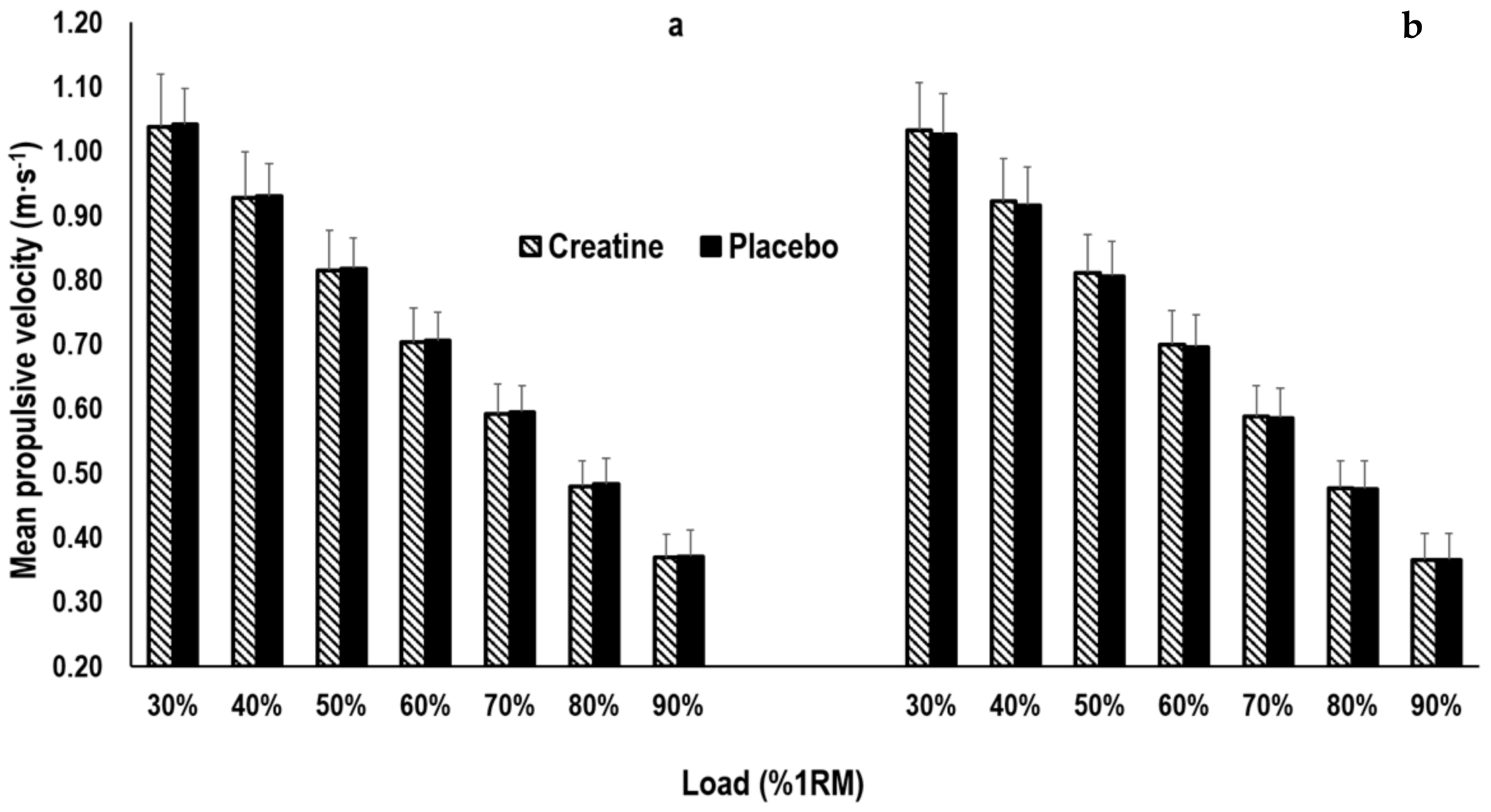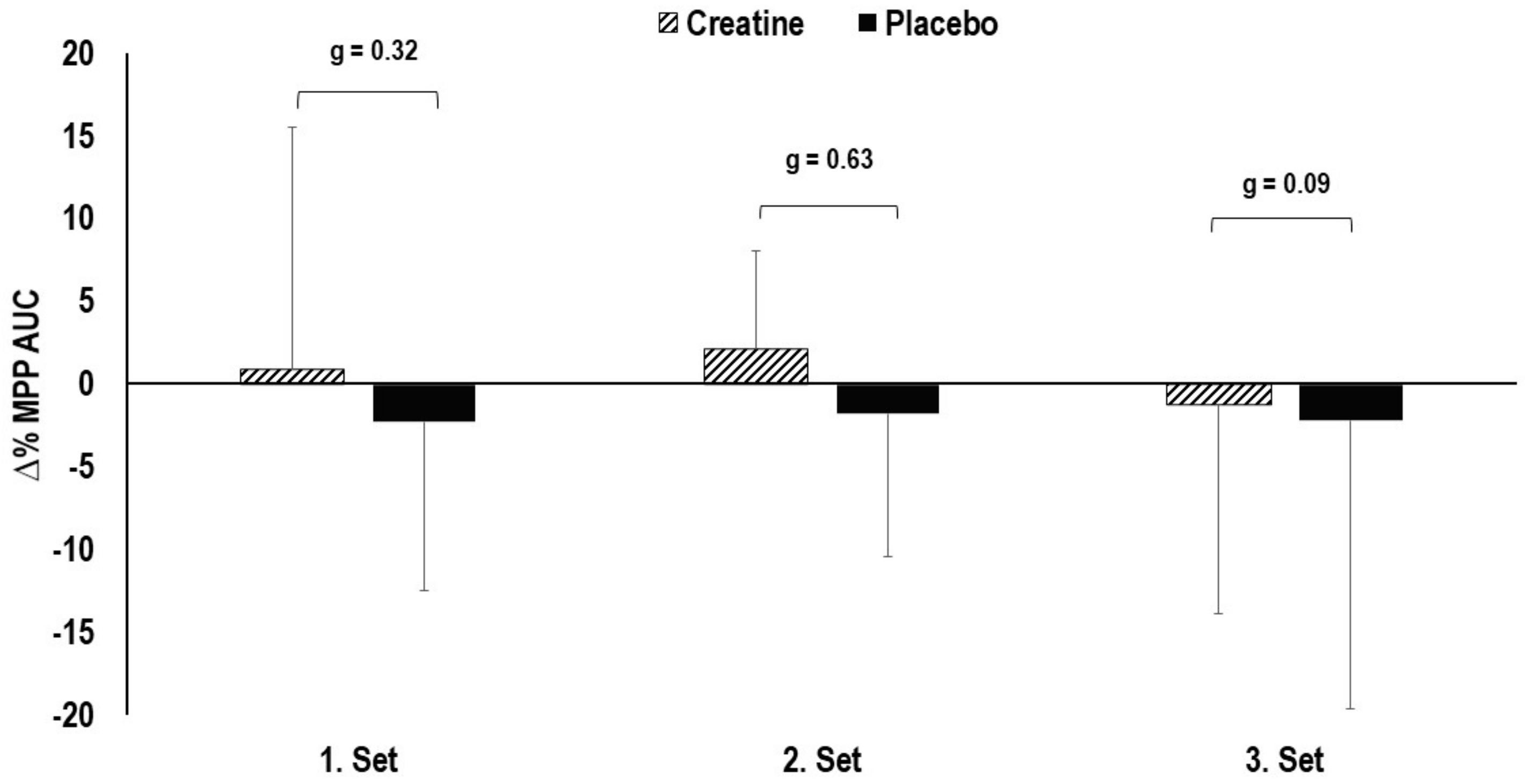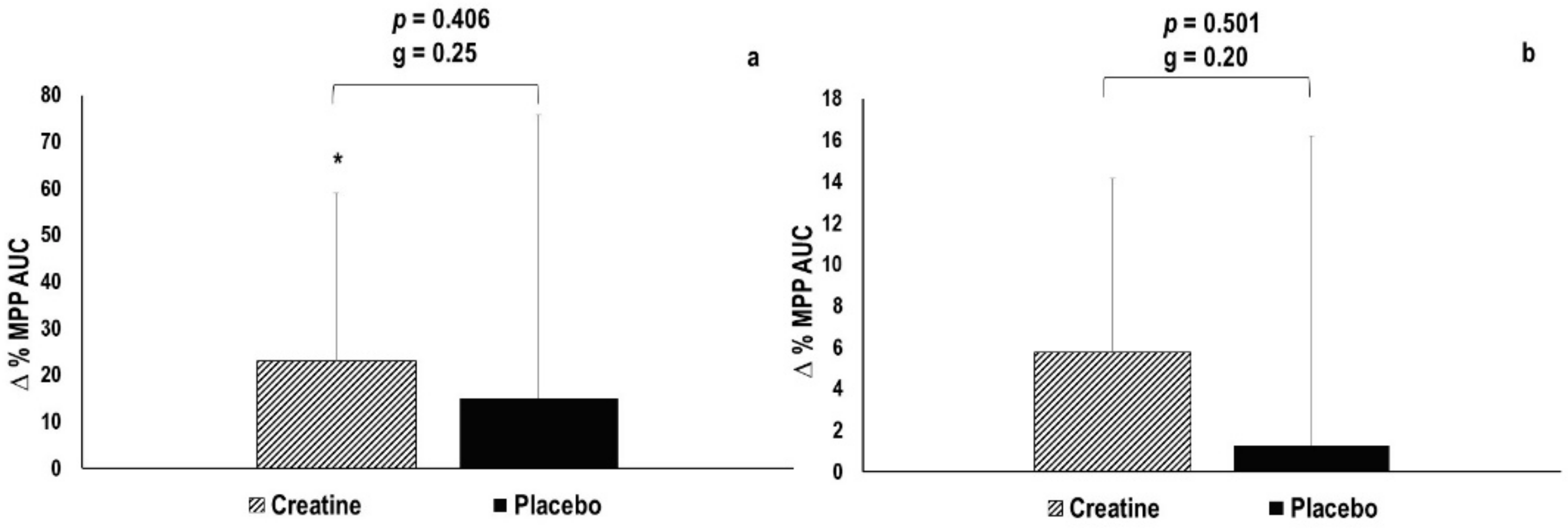Short-Term Creatine Loading Improves Total Work and Repetitions to Failure but Not Load–Velocity Characteristics in Strength-Trained Men
Abstract
:1. Introduction
2. Materials and Methods
2.1. Experimental Design
2.2. Participants
2.3. Procedures
2.3.1. Strength Testing and Load–Velocity Profiling
2.3.2. Deep Squat Protocol (3 × 10 Repetitions)
2.3.3. Repetitions-to-Failure Test
2.3.4. Urine Sampling
2.3.5. Statistical Analysis
3. Results
3.1. Baseline Comparison
3.2. Maximal Strength and Load–Velocity Characteristics
3.3. Deep Squat Protocol (3 × 10 Repetitions)
3.4. Repetitions-to-Failure Test
3.5. Body Mass and Creatinine Excretion
4. Discussion
5. Conclusions
Author Contributions
Funding
Institutional Review Board Statement
Informed Consent Statement
Data Availability Statement
Conflicts of Interest
References
- Bemben, M.G.; Lamont, H.S. Creatine Supplementation and Exercise Performance Recent Findings. Sports Med. 2005, 35, 107–125. [Google Scholar] [CrossRef]
- Kreider, R.B. Effects of Creatine Supplementation on Performance and Training Adaptations. Mol. Cell. Biochem. 2003, 244, 89–94. [Google Scholar] [CrossRef]
- Maughan, R.J. Creatine Supplementation and Exercise Performance. Int. J. Sport Nutr. Exerc. Metab. 1995, 5, 94–101. [Google Scholar] [CrossRef]
- Terjung, R.J.; Clarkson, P.; Eichner, E.R.; Greenhaff, P.L.; Hespel, P.J.; Israel, R.G.; Kraemer, W.J.; Meyer, R.A.; Spriet, L.L.; Tarnopolsky, M.A.; et al. Physiological and Health Effects of Oral Creatine Supplementation. Med. Sci. Sport. Exerc. 2000, 32, 706–717. [Google Scholar] [CrossRef] [Green Version]
- Bird, S.P. Creatine Supplementation and Exercise Performance: A Brief Review. J. Sports Sci. Med. 2003, 2, 123. [Google Scholar]
- Lanhers, C.; Pereira, B.; Naughton, G.; Trousselard, M.; Lesage, F.X.; Dutheil, F. Creatine Supplementation and Lower Limb Strength Performance: A Systematic Review and Meta-Analyses. Sports Med. 2015, 45, 1285–1294. [Google Scholar] [CrossRef]
- Nissen, S.L.; Sharp, R.L. Effect of Dietary Supplements on Lean Mass and Strength Gains with Resistance Exercise: A Meta-Analysis. J. Appl. Physiol. 2003, 94, 651–659. [Google Scholar] [CrossRef]
- Volek, J.S.; Rawson, E.S. Scientific Basis and Practical Aspects of Creatine Supplementation for Athletes. Nutr. J. 2004, 20, 609–614. [Google Scholar] [CrossRef]
- Izquierdo, M.; Ibanez, J.; González-Badillo, J.J.; Gorostiaga, E.M. Effects of Creatine Supplementation on Muscle Power, Endurance, and Sprint Performance. Med. Sci. Sports Exerc. 2002, 34, 332–343. [Google Scholar] [CrossRef]
- Law, Y.L.L.; Ong, W.S.; GillianYap, T.L.; Lim, S.C.J.; Von Chla, E. Effects of Two and Five Days of Creatine Loading on Muscular Strength and Anaerobic Power in Trained Athletes. J. Strength Cond. Res. 2009, 23, 906–914. [Google Scholar] [CrossRef]
- Zuniga, J.M.; Housh, T.J.; Camic, C.L.; Hendrix, C.R.; Mielke, M.; Johnson, G.O.; Housh, D.J.; Schmidt, R.J. The Effects of Creatinemonohydrate Loading on Anaerobic Performance and One-Repetition Maximum Strength. J. Strength Cond. Res. 2012, 26, 1651–1656. [Google Scholar] [CrossRef]
- Eckerson, J.M.; Stout, J.R.; Moore, G.A.; Stone, N.J.; Iwan, K.A.; Gebauer, A.N.; Ginsberg, R. Effect of Creatine Phosphate Supplementation on Anaerobic Working Capacity and Body Weight after Two and Six Days of Loading in Men and Women. J. Strength Cond. Res. 2005, 19, 756. [Google Scholar] [CrossRef]
- Morin, J.B.; Samozino, P. Interpreting Power-Force-Velocity Profiles for Individualized and Specific Training. Int. J. Sport Physiol. 2016, 11, 267–272. [Google Scholar] [CrossRef]
- González-Bandillo, J.J.; Sánchez-Medina, L. Movement Velocity as a Measure of Loading Intensity in Resistance Training. Int. J. Sports Med. 2010, 31, 347–352. [Google Scholar] [CrossRef]
- Martínez-Cava, A.; Morán-Navarro, R.; Sánchez-Medina, L.; González-Bandillo, J.J.; Pallarés, J.G. Velocity- and Power-Load Relationships in the Half, Parallel and Full Back Squat. J. Sports Sci. 2019, 37, 1088–1096. [Google Scholar] [CrossRef]
- Sánchez-Medina, L.; Pallarés, J.; Pérez, C.; Morán-Navarro, R.; González-Badillo, J. Estimation of Relative Load From Bar Velocity in the Full Back Squat Exercise. Sport. Med. Int. Open 2017, 1, 80. [Google Scholar] [CrossRef]
- Sánchez-Medina, L.; González-Badillo, J.J. Velocity Loss as an Indicator of Neuromuscular Fatigue during Resistance Training. Med. Sci. Sports Exerc. 2011, 43, 1725–1734. [Google Scholar] [CrossRef]
- Loturco, I.; Pereira, L.A.; Morales, J.E.; Kitamura, K.; Abad, C.C.C.; Kobal, R.; Nakamura, F.Y. Jump-Squat and Half-Squat Exercises: Selective Influences on Speed-Power Performance of Elite Rugby Sevens Players. PLoS ONE 2017, 12, e0170627. [Google Scholar] [CrossRef] [Green Version]
- Loturco, I.; Nakamura, F.Y.; Tricoli, V.; Kobal, R.; Abad, C.C.C.; Kitamura, K.; Ugrinowitsch, C.; Gil, S.; Pereira, L.A.; González-Badillo, J.J. Determining the Optimum Power Load in Jump Squat Using the Mean Propulsive Velocity. PLoS ONE 2015, 10, e0140102. [Google Scholar] [CrossRef] [PubMed]
- Loturco, I.; Pereira, L.A.; Kobal, R.; Kitamura, K.; Cala Bad, C.C.; Nakamura, F.Y.; Pai, C.N. Peak versus Mean Propulsive Power Outputs: Which Is More Closely Related to Jump Squat Performance? J. Sports Med. Phys. Fitness 2017, 57, 1432–1444. [Google Scholar] [CrossRef] [PubMed]
- Hall, M.; Trojian, T.H. Creatine Supplementation. Curr. Sports Med. Rep. 2013, 12, 240–244. [Google Scholar] [CrossRef]
- Faul, F.; Erdfelder, E.; Lang, A.G.; Buchner, A. G*Power 3: A Flexible Statistical Power Analysis Program for the Social, Behavioral, and Biomedical Sciences. Behav. Res. Methods 2007, 39, 175–191. [Google Scholar] [CrossRef]
- Hedges, L.V. Distribution theory for Glass’s estimator of effect size and related estimators. J. Educ. Stat. 1981, 6, 107–128. [Google Scholar] [CrossRef]
- Cohen, J. The effect size index: D. In Statistical Power Analysis for the Behavioral Sciences; Routledge: New York, NY, USA, 1988; Volume 2, pp. 284–288. [Google Scholar]
- Gastin, P.B. Energy System Interaction and Relative Contribution during Maximal Exercise. Sports Med. 2001, 31, 725–741. [Google Scholar] [CrossRef]
- Urbanski, R.L.; Loy, S.F.; Vincent, W.J.; Yaspelkis, B.B. Creatine Supplementation Differentially Affects Maximal Isometric Strength and Time to Fatigue in Large and Small Muscle Groups. Int. J. Sport Nutr. 1999, 9, 136–145. [Google Scholar] [CrossRef] [PubMed]
- Casey, A.; Greenhaff, P.L. Does Dietary Creatine Supplementation Play a Role in Skeletal Muscle Metabolism and Performance? Am. J. Clin. Nutr. 2000, 72, 607–6017. [Google Scholar] [CrossRef]
- Greenhaff, P.L.; Casey, A.; Short, A.H.; Harris, R.; Soderlund, K.; Hultman, E. Influence of Oral Creatine Supplementation of Muscle Torque during Repeated Bouts of Maximal Voluntary Exercise in Man. Clin. Sci. 1993, 84, 565–571. [Google Scholar] [CrossRef] [PubMed] [Green Version]
- Vandenberghe, K.; Goris, M.; Van Hecke, P.; Van Leemputte, M.; Vangerven, L.; Hespel, P. Long-Term Creatine Intake Is Beneficial to Muscle Performance during Resistance Training. J. Appl. Physiol. 1997, 83, 2055–2063. [Google Scholar] [CrossRef]
- Volek, J.S.; Kraemer, W.J.; Bush, J.A.; Boetes, M.; Incledon, T.; Clark, K.L.; Lynch, J.M. Creatine Supplementation Enhances Muscular Performance during High-Intensity Resistance Exercise. J. Am. Diet. Assoc. 1997, 97, 765–770. [Google Scholar] [CrossRef]
- Hultman, E.; Söderlund, K.; Timmons, J.A.; Cederblad, G.; Greenhaff, P.L. Muscle Creatine Loading in Men. J. Appl. Physiol. 1996, 81, 232–237. [Google Scholar] [CrossRef]
- Vandenberghe, K.; Van Hecke, P.; Van Leemputte, M.; Vanstapel, F.; Hespel, P. Phosphocreatine Resynthesis Is Not Affected by Creatine Loading. Med. Sci. Sports Exerc. 1999, 31, 236–242. [Google Scholar] [CrossRef] [PubMed]
- Schedel, J.M.; Tanaka, M.; Tanaka, H.; Kiyonaga, A.; Shindo, M.; Terrier, P.; Schutz, Y. Consequences of one-week creatine supplementation on creatine and creatinine levels in athletes’ serum and urine. Schweiz. Z. Sportmed. Sporttraumatol. 2000, 3, 111–116. [Google Scholar]





| Pre-Creatine | Pre-Placebo | p-Value, g | |
|---|---|---|---|
| Absolute 1RM (kg) | 135.2 ± 21.6 | 134.5 ± 20.9 | 0.524, 0.20 |
| Relative 1RM (kg·kg−1) | 1.5 ± 0.2 | 1.5 ± 0.2 | 0.588, 0.16 |
| Load–velocity characteristics (regression equation of load and MPV in m·s−1) | f(MPV) = (–0.008x) + 1.37 | f(MPV) = (–0.009x) + 1.38 | 0.995, <0.08 |
| Total work (3 × 10 repetitions) (J) | 3363.5 ± 649.1 | 3403.9 ± 799.8 | 0.524, 0.19 |
| Repetitions to failure (RFT) | 10.9 ± 3.6 | 11.2 ± 4.0 | 0.732, 0.10 |
| Total work (RFT) (J) | 3435.6 ± 1340.2 | 3656.7 ± 1849.8 | 0.371, 0.27 |
| MPP normalized per repetition (RFT) (J) | 313.9 ± 58.7 | 321.3 ± 76.7 | 0.394, 0.26 |
Publisher’s Note: MDPI stays neutral with regard to jurisdictional claims in published maps and institutional affiliations. |
© 2021 by the authors. Licensee MDPI, Basel, Switzerland. This article is an open access article distributed under the terms and conditions of the Creative Commons Attribution (CC BY) license (http://creativecommons.org/licenses/by/4.0/).
Share and Cite
Feuerbacher, J.F.; von Schöning, V.; Melcher, J.; Notbohm, H.L.; Freitag, N.; Schumann, M. Short-Term Creatine Loading Improves Total Work and Repetitions to Failure but Not Load–Velocity Characteristics in Strength-Trained Men. Nutrients 2021, 13, 826. https://doi.org/10.3390/nu13030826
Feuerbacher JF, von Schöning V, Melcher J, Notbohm HL, Freitag N, Schumann M. Short-Term Creatine Loading Improves Total Work and Repetitions to Failure but Not Load–Velocity Characteristics in Strength-Trained Men. Nutrients. 2021; 13(3):826. https://doi.org/10.3390/nu13030826
Chicago/Turabian StyleFeuerbacher, Joshua F., Valerian von Schöning, Judith Melcher, Hannah L. Notbohm, Nils Freitag, and Moritz Schumann. 2021. "Short-Term Creatine Loading Improves Total Work and Repetitions to Failure but Not Load–Velocity Characteristics in Strength-Trained Men" Nutrients 13, no. 3: 826. https://doi.org/10.3390/nu13030826







